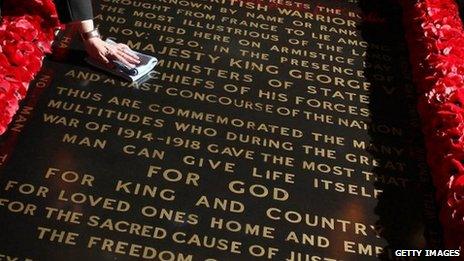The unknown soldier's journey from trench to tomb
- Published

The tomb, in London's Westminster Abbey
The unknown warrior was carried from a French battlefield 90 years ago, to be laid to rest among kings and statesmen in Westminster Abbey. But how did this symbol of the sacrifice of war come to be chosen?
In 1916, a Church of England clergyman serving at the Western Front in World War I spotted an inscription on an anonymous war grave which gave him an idea.
That moment of inspiration would blossom into a worldwide ceremony that is still being replicated in the 21st Century - the grave of an unknown warrior, symbolising those who made the ultimate sacrifice for their country.
The Reverend David Railton caught sight of the grave in a back garden at Armentieres in France in 1916, with a rough cross upon which was pencilled the words "An Unknown British Soldier".
In August 1920 Mr Railton wrote to the Dean of Westminster, Herbert Ryle, to suggest having a nationally recognised grave for an unknown soldier. The idea - which had also been mooted by the Daily Express newspaper the year before - was presented to the government and quickly taken up.
Memories of the war, in which a million British people had died, were still raw and the thousands of bodies that lay unidentified were a blight on Britain's conscience.
"Those parents and wives who had lost men to war didn't have anything tangible to grieve at, so the unknown warrior represented their loss," says Terry Charman, a historian at the Imperial War Museum.
But there was a procedure in choosing a single corpse to represent the many unnamed dead. The unknown warrior's body was chosen from a number of British servicemen exhumed from four battle areas - the Aisne, the Somme, Arras and Ypres. These remains were brought to the chapel at St Pol on the night of 7 November 1920, where the officer in charge of troops in France and Flanders, Brig Gen L J Wyatt, went with a Col Gell.
Neither had any idea where the bodies, laid on stretchers and covered by union jacks, were from.
"The point was that it literally could have been anybody," says Mr Charman. "It could have been an earl or a duke's son, or a labourer from South Africa.
"The idea really caught the public mood, as it was a very democratic thing that it could have been someone from any rank."
Gen Wyatt selected one body - it has been suggested he may have been blindfolded while making his choice - and the two officers placed it in a plain coffin and sealed it. The other bodies were reburied.
The next day the dead soldier began the journey to his final resting place. The coffin was taken to Boulogne and placed inside another coffin, made of oak from Hampton Court and sent over from England. Its plate bore the inscription: "A British Warrior who fell in the Great War 1914-1918 for King and Country".
This second coffin had a 16th Century sword, taken from King George V's private collection, fixed on top.
The body was then transported to Dover via the destroyer HMS Verdun and taken by train to London.
On the morning of 11 November 1920 - two years to the day after the war had ended, the body of the unknown warrior was drawn in a procession through London to the Cenotaph. This new war memorial on Whitehall was then unveiled by George V.
At 1100 there was a two-minute silence, and the body was then taken to nearby Westminster Abbey where it was buried, passing through a guard of honour of 100 holders of the Victoria Cross.
In a particularly poignant gesture, the grave was filled with earth from the main French battlefields, and the black marble stone was Belgian.
And at the exact time Britain was interring its unknown warrior, France was doing the same - burying its Soldat Inconnu at the Arc de Triomphe in Paris.
But while the coffin in London had been laid with great ceremony, no-one was exactly sure how the public would respond to this new memorial. In the event, they flocked to it. An estimated 1,250,000 people visited the Abbey to see the grave in only the first week.
Ninety years on, the dead soldier continues to be honoured, by the public and royalty alike.
What's more, the symbolism of the act has been mirrored by many other countries around the world. Iraq, the United States, Germany, Lithuania and Poland are just some of those which have created their own memorials.
On 17 October 1921, Britain's unknown soldier was given the US Medal of Honor, America's highest award for bravery, which hangs on a pillar near his grave. On 11 November 1921, the US unknown soldier was reciprocally awarded the Victoria Cross.
And the commemorations have continued - Australia's unknown soldier was buried at Canberra in 1993 and a Canadian equivalent interred in Ottawa in 2000. Six years ago, New Zealand exhumed remains from the Somme in France and buried its own unknown warrior.
Mr Charman says the diminishing significance of the Commonwealth may have added to the need for individual nations, which were once part of the British Empire, to create their own memorials.
"Nowadays, the concept of Commonwealth is much diminished. It doesn't mean anything in the same way it did years ago.
"To have its own unknown warrior, for a country that sent troops to WWI, is part of its own national identity."